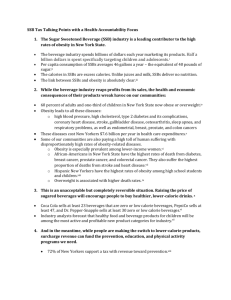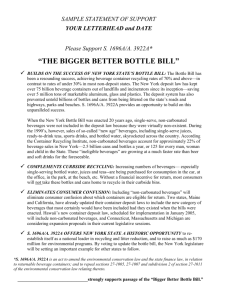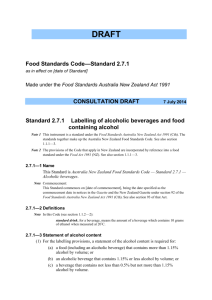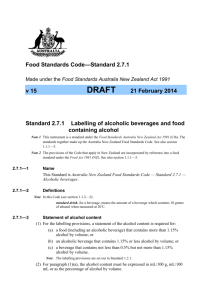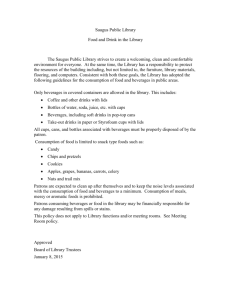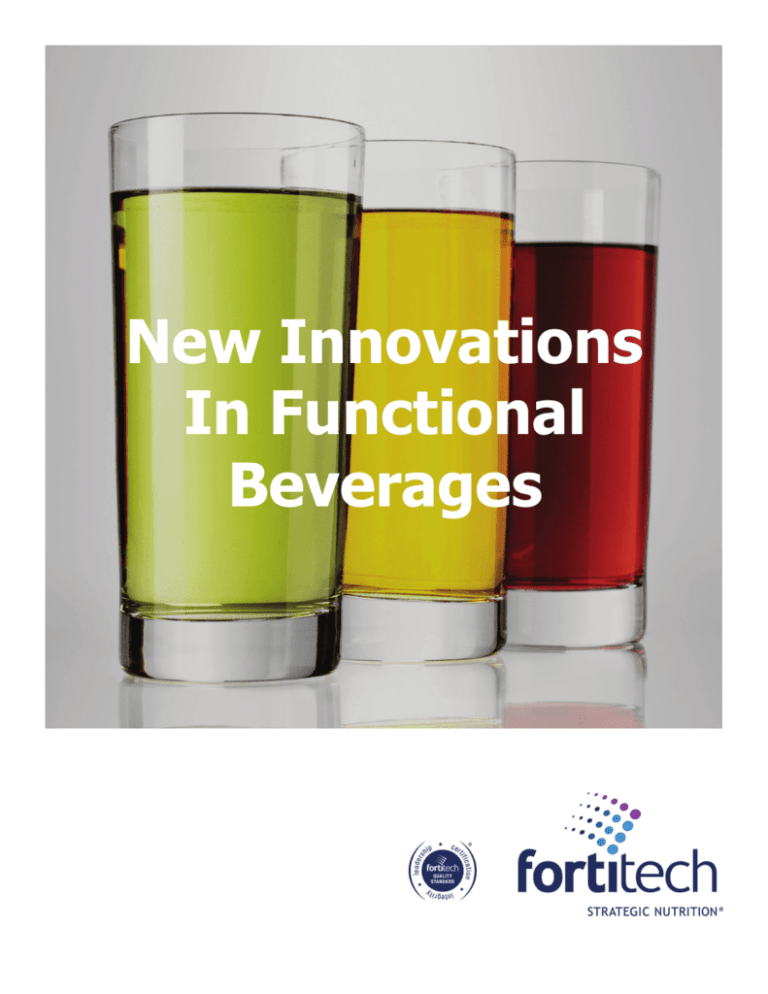
New Innovations
In Functional
Beverages
PAGE
2
Functional beverages play an important role in our everyday lives. They help keep us hydrated, prevent and help address health conditions, aid in our athletic performance or simply contribute to our overall nutritional well-being. The beverage industry has experienced
rapid growth over the past decade, especially in North America, and it’s very apparent when
looking at the store shelves of any grocery store. The choices for beverages have become
so specific that they appear to be almost tailored for an individual, representing an extension of one’s personality. Consumers have their choice of beverages that aid in boosting
energy, shrinking waistlines, sharpening mental focus, preventing pain associated with bone
and joint conditions, and the list goes on. In addition, there are beverages that are specific
for each age demographic and gender, with a growing focus on products targeting kids,
women and seniors. This diversification in beverages in conjunction with the increased
channels in distribution continue to fuel consumer demand.
With Fortitech’s
global network of
facilities, we can
fortify virtually any
The functional beverage market has steadily increased over the past decade, with a sharper
rise in the last couple of years. According to Datamonitor, the global non-alcoholic beverage market is valued at just under $500 billion worldwide, with Europe accounting for the
largest portion at $189 billion. China has become the fastest growing country at an overall
growth rate of 77% over the past decade.
beverage with any
nutrient, anywhere in
Market Value by Country for 2000-2014
Represented in US$ Millions
the world
Source: Datamonitor
Fortified beverages are just a fraction of the total non-alcoholic beverage market, valued at
an estimated $60 billion, according to Euromonitor. Over 80% of this market can be attributed to sales from North America, Western Europe and Asia Pacific.
N E W
I N N O V A T I O N S
I N
F U N C T I O N A L
B E V E R A G E S
P A G E
2
PAGE
2
2009 Worldwide Fortified Beverage Sales by Region
Fortitech’s team of
global technical
experts can help you
with any formulation
Represented in US$ Billions
Region World Asia Pacific Australasia Eastern Europe Latin America Middle East and Africa North America Western Europe challenge
2004
$38,493
$13,940
$595
$639
$2,783
$675
$12,780
$7,081
2005
$43,438
$14,323
$659
$847
$3,278
$848
$15,950
$7,534
2006
$48,301
$14,779
$731
$1,084
$3,812
$974
$18,686
$8,236
2007 $54,508 $15,454 $914 $1,542 $4,481 $1,133 $21,346 $9,638 2008 $60,006 $17,206 $1,014 $2,040 $5,301 $1,281 $22,552 $10,611 2009
$59,936
$18,148
$876
$1,626
$5,312
$1,231
$23,204
$9,539
Source: Euromonitor
Advancements in product development processes and technology coupled with beverage
manufacturers embracing open innovation, is paving the path for processors to get functional beverages to store shelves faster. This presents a great opportunity for beverage
manufacturers, as they can now react to shifts in consumer demands much quicker, such as
the rise of immunity drinks which can be attributed partly to consumers desiring products
that build up their defenses in response to the expediential spread of the H1N1 virus. In
addition, due to rapid advancements in taste masking and microencapsulation, beverage
manufacturers have a wider selection of nutrients to choose from. For example, amino acids which typically carry a bitter taste can now be added to beverages to aid in sports recovery, performance or beverages targeting energy as taste masking can now hide the bitter tastes. The same goes for omega 3 which typically carries “fishy” off-notes, can now be
microencapsulated to hide the unpleasant taste, and still deliver the nutritional benefit of
the nutrient.
In virtually every region of the world, functional beverages are an important part of the lifestyle for each diverse culture. Asian countries tend to favor dairy based beverages, where
U.S. and Europe favors more of a range of products spanning from enhanced waters to
juices. Mexico and South America have seen rapid growth in sports drinks as well as energy beverage consumption. And just as different applications seem to be more prevalent
N E W
I N N O V A T I O N S
I N
F U N C T I O N A L
B E V E R A G E S
P A G E
3
PAGE
2
in different regions, so is the color and taste of each of the beverages. This paper will address the top nutrients utilized in beverages, color trends and taste preferences as well as
provide specific nutrient formulations that target in-demand categories such as weight management, nutricosmetics, and energy.
Functional Beverage Applications
The beverage experience in today’s marketplace is completely different than 10 or even five
years ago. The manner in which beverages are consumed is just as interesting as what
functional ingredients are in it. Today consumers have their choice of a traditional eight
ounce or 12 ounce beverage, powder mix with added nutrients, a two ounce shot with a
potent mixture of nutrients, and the list goes on. Some of the top functional beverage
categories and unique delivery methods are outlined below.
Whether you desire
8 ingredients or 80
(or more), Fortitech
can develop a single
premix to address
your needs
Shots
Beverage shots, which typically are delivered in a small, portable, single-serve two or three
ounce bottle, contain a potent mix of nutrients geared to perform a specific function. The
shot originated as a delivery system for a fast-acting boost of energy with less sugar and
calories than a 12 ounce energy drink product. Energy shots typically include functional
ingredients geared to provide an initial boost of energy with a lasting effect, which are caffeine, taurine, D-ribose, B vitamins, flavoring and a sweetener. The energy shot market
has dramatically increased over the past couple of years. Innova Market Insights tracked
80 products marketed as an ‘energy shot’ from Oct 08-Oct 09, compared to 23 in the previous 12 months. As consumer acceptance increased, new targeted shots entered the market, such as products geared toward promoting a healthy gut, boosting immunity, enhancing mood, and shots that deliver a mix of nutrients that encourage relaxation. Shots have
seen a shift in the sweetener used in the past 12 months, where most single-serve shots
are now boasting no sugar and low calories. Shots provide a convenient way to deliver a
nutritional benefit as an alternative to supplements or pills. In Japan, shots have become a
staple for taking specific nutrients, as well as a vehicle for consumers to try out new functional ingredients. Shot products are typically positioned at the point-of-purchase for a
quick grab-and-go product.
Stick Packs
Beverages are truly an on-the-go product that can be consumed at anytime of the day.
Advancements in packaging and delivery systems, such as stick packs, have made beverages even more convenient. Stick packs are an excellent delivery method for a controlled
portion of functional ingredients in powdered form. This method increases the shelf life of
the functional ingredients, makes a beverage product ultra-portable, and offers the opportunity to dispense into a beverage in virtually any setting. Stick packs are used to deliver
many types of beverages such as coffee, RTD tea’s, enhanced waters, and energy drinks.
They can be delivered into any type of beverage including water, juice, coffee and even
milk. They also are used to target virtually any lifestyle, health condition and age demographic, making their focus limited only by the creativity of the concept developer. Stick
packs usually include a blend of nutrients, sweetener, color, flavor, masking agents, with
added stabilizers that promote good mouth feel and enhance the flavor. Advancements in
taste masking technology have allowed formulators to develop stick packs with a high potency of nutrients which can be delivered in numerous product applications with suitable
doses. Overall, this delivery system has gained increased consumer acceptance over the
years and is a portable, easy-to-use product that can be consumed in virtually any setting.
N E W
I N N O V A T I O N S
I N
F U N C T I O N A L
B E V E R A G E S
P A G E
4
PAGE
2
Ready-To-Drink Teas
Black, Green, Oolong, White, Yerba Mate, Rooibus… At a time when interest in health and
wellness foods is continually increasing, the ‘natural’ platform offered by tea, accompanied
by its already perceived health status due to its polyphenol content, is a major attraction for
consumers. While tea is of interest to several market segments, it may be of particular interest to baby boomers who are interested in products that can aid in their quest to manage a myriad of health conditions ranging from weight loss to cognitive function and heart
health. And, regardless of its type, RTD teas are a convenient and desirable vehicle for fortification that can add even more health benefits to this timeless drink.
The fortified ready-to-drink tea market has grown worldwide from $1.4 billion to $2.6 billion
from 2004 to 2009, according to Euromonitor. There was a steady growth in this category
from 2004 to 2007, with a greater increase in sales from 2007 through 2009.
Fortitech can
Worldwide Fortified RTD Teas from 2004 to 2009
Represented in US$ Millions
develop a premix to
address any health
condition, lifestyle or
age demographic
Source: Euromonitor
Between 2002 and 2007, the RTD tea market grew 334%. With Datamonitor reporting 775
SKUs from 327 RTD tea products launched worldwide in the past year, the market for fortification within this product category is wide open and offers opportunities for manufacturers
to develop and introduce products that one might term “Super Teas.” Currently being introduced into the marketplace are RTD teas that incorporate super fruit extracts such as
pomegranate and mangosteen. The market remains wide open for RTD tea concept developers to add functional ingredients that may greatly increase consumer appeal and drive
sales.
Sports Drink/Recovery Drink
The main function of sports drinks is to keep athletes hydrated while restoring the electrolytes, carbohydrates and other nutrients, which can be depleted from exercising. Sports
drinks are developed using essential electrolytes like sodium, potassium, chloride, calcium,
phosphate and magnesium, which are lost by sweating during exercise. Amino acids are
used to slow fatigue and improve muscle function while B vitamins are used to boost metabolism and generate energy. Simple carbohydrates can be used for a quick energy burst
and complex carbohydrates can be used for sustained energy.
N E W
I N N O V A T I O N S
I N
F U N C T I O N A L
B E V E R A G E S
P A G E
5
PAGE
2
Worldwide Fortified Sports Drinks from 2004 to 2009
Represented in US$ Millions
Every functional
ingredient that
Fortitech utilizes
must pass rigorous
Source: Euromonitor
testing for potency,
impurities and
accuracy
Worldwide the fortified sports drink market topped nearly $18 billion in 2008, and then decreased to just under $16 billion in 2009, according to Euromonitor.
Dairy Based
Milk has often been called “nature’s perfect food” and dairy based beverages such as drinkable yogurts, continue to be a staple of a healthy
diet in many parts of the world. In the West, dairy
products supply over 20% of the daily requirement
for calcium and also supply a significant amount of
vitamins A, D, B12 and riboflavin (vitamin B2) as
well as minerals such as magnesium and potassium. These ingredients are used as basic building
blocks of many products to deliver other nutritional
products which are fortified with vitamins and minerals. Whey proteins and hydrolyzed proteins are
also used as an important foundation to build new
products for different health condition-specific
products.
Dairy based beverages are an ideal delivery vehicle
for fatty acids, as well as antioxidants, protein and
other functional ingredients because refrigeration
helps to keep these ingredients active. And, because of their relatively short shelf life, most fragile
ingredients won’t degrade prior to consumption. The challenge is, however, choosing the
right functional nutrients and formulating a message that works. Dairy based yogurt beverages can be developed with photidylcholine, omega 3 and hydrolyzed collagen ingredients
which can be part of a healthy diet.
Juice
Datamonitor reports that for the year 2009, over 4,000 SKUs from 1,437 juice products
N E W
I N N O V A T I O N S
I N
F U N C T I O N A L
B E V E R A G E S
P A G E
6
PAGE
2
were launched and aside from flavor blends, apple, orange and peach were the leading flavors of juices launched globally during 2009.
Universal in its appeal, juices are perceived as healthy and as a good source of fortification.
However, there is a great opportunity to add additional functional ingredients that can
greatly enhance the appeal to consumers. Euromonitor reports that the areas for growth
include products that target gut health, immune system support, weight management,
beauty-from-within and heart health. And, among the nutrients sought after by consumers
within this category include omega 3 fatty acids and CoQ10 for heart health, fiber and probiotics for both gut health and weight management, collagen for beauty-from-within and
vitamin D and zinc for enhanced immunity.
Fortitech’s premixes
are optimized to
withstand product
According to Euromonitor, the worldwide fortified fruit/vegetable juice market topped out at
just over $10 billion in 2008.
Worldwide Fortified Fruit/Vegetable Juice from 2004 to 2009
Represented in US$ Millions
processing conditions,
shelf life requirements
and performance
specifications
Source: Euromonitor
One key point that manufacturers should take into consideration with this particular category is the current focus the media has placed on sugar content, which affects the juice
category. Consumers are looking for products that specifically call out claims such as ‘low
sugar’ or ‘unsweetened’ or ‘no sugar added’ and that claims such as these can greatly influence consumer purchasing decisions. This is especially critical for juices targeting kids.
Enhanced Waters
Enhanced waters are any type of water that adds a functional benefit above and beyond
hydration. This above and beyond water category is one of the more widely used applications to target not only overall wellness, but a whole host of lifestyles and health conditions,
from aiding in vision to nutricosmetics to enhancing immunity and defending against illness
and disease. It has become widely accepted by all types of age demographics and regions
of the world as a way to get hydrated and get a daily dose of nutrients.
Based on the numbers reported by Euromonitor, the fortified water and elixir category has
grown exponentially from 2005 to 2009.
N E W
I N N O V A T I O N S
I N
F U N C T I O N A L
B E V E R A G E S
P A G E
7
PAGE
2
Worldwide Fortified Water and Elixirs from 2004 to 2009
Represented in US$ Millions
There is an art and
science to developing
customized nutrient
premixes and
Fortitech delivers on
both
N E W
I N N O V A T I O N S
Source: Euromonitor
Energy Drinks
Energy drinks outpaced the growth of conventional carbonated beverages, registering a
CAGR of 12.8% during 2003–08, almost three times that of the carbonated drinks category,
as reported by Datamonitor. Energy beverages originated in Japan in the 1960’s to help
the salaried class work long hours and then made its way to America in 1997 and is now
gaining traction in the United Kingdom, Brazil and India. And what was once contained to
just the beverage category has now spread to other product delivery vehicles such as confectionery, bars, juices and
cereal. However, the energy
beverage category is arguably the most personalized of
any other product application – featuring energy
drinks for men, women and
as an expression of virtually
anything associated with
delivering energy. Datamonitor reports that within
the last five years, there
have been over 3,390 SKU’s
comprised of 1,640 new energy product launches. Information Resources Inc.,
Chicago values the total U.S. energy drink market at just under $900 million (U.S. supermarkets, drug stores and mass merchandise outlets excluding Walmart for the 52 weeks
ending May 17, 2009). And very similar to other beverage applications, the energy drink
category is appealing to the health conscious market by lowering the carbohydrate, calorie
and sugar content.
I N
F U N C T I O N A L
B E V E R A G E S
P A G E
8
PAGE
2
Worldwide Fortified Energy Beverages from 2004 to 2009
Represented in US$ Millions
Trust and confidence
are key ingredients
you’ll find in every
Fortitech premix
Source: Euromonitor
Based on the numbers reported by Euromonitor, the fortified energy beverage category has
more than doubled over the past five years, topping out at $14 billion in 2009.
Functional Ingredients
The functional beverage category is a vibrant growing market and very personalized. Beverages still remain as the ultimate grab-and-go product, but now consumers can combine hydration with
performance or even as a preventative measure for
specific health conditions. Beverages are beginning
to incorporate a more expansive line of functional
ingredients such as nutraceuticals, zero-calorie
sweeteners and flavors that not only taste good but
are good for you. There is such a wide array of
functional ingredients on the market today making
beverage innovation much easier, limited more by
the imagination than product development challenges. Custom nutrient premixes are one
way to make a beverage product unique and pending the number of ingredients utilized,
could be less likely imitated in the marketplace. Functional ingredients include nutrients
(vitamins, minerals, amino acids, nutraceuticals, etc.), flavors, sweeteners, stabilizers, and
colors which are all highlighted in this paper.
Nutrients
There are hundreds of nutrient market forms to choose from when developing a beverage
concept. The illustration below highlights some of the major categories of functional nutrients most commonly used in beverages as well as some of the more trendy ingredients that
are making their way into beverages, thanks in part to advancements in taste masking, microencapsulation and nanotechnology. Each nutrient is geared to provide a specific function in the body, but as nutrients are combined, they can enhance bioavailability of other
nutrients and ingredient potency as it relates to addressing a specific health condition. Nutrient selection can be a very daunting task, so it helps to specifically define the ultimate
N E W
I N N O V A T I O N S
I N
F U N C T I O N A L
B E V E R A G E S
P A G E
9
PAGE
2
benefit the beverage will provide the end consumer. Beverages are great vehicles for delivering nutrients that aid in relaxation, energy, mental focus, immunity, weight management,
beauty, and relief from bone and joint pain. The illustration below highlights some of the
classic nutrients as well as some of the trendy functional ingredients making an appearance
in beverages.
Fortitech can source
over 1,400 quality
nutrients from
around the world
Antioxidants
The most common antioxidant cocktail is the combination of vitamins A, C, and E. They are
arguably the most highly utilized nutrients in beverages aimed at targeting free radicals in
the body and could equally be the most recognized by consumers. The main goal of antioxidants is to fight free radicals which are believed to be responsible and linked to many
leading diseases in the world. Zinc is a key mineral that works as an antioxidant and an
essential part of more than 200 enzymes involved in digestion, metabolism, reproduction
and wound healing. Antioxidants may be utilized in beverages to help boost immunity, improve circulation and sharpen mental acuity.
Nutraceuticals
Nutraceuticals is a catch-all place for all nutrients that do not fall under one of the other
categories such as vitamins, minerals, amino acids, etc. The term nutraceutical was coined
in the 1990's by Dr. Stephen DeFelice. He defined nutraceutical as: 'A nutraceutical is any
substance that is a food or a part of a food and provides medical or health benefits, including the prevention and treatment of disease.’
Fiber is an in-demand nutraceutical that continues to gain more consumer attention and
demand. The United States Department of Agriculture stated that only one in five Americans are getting the recommended daily amount of fiber (25 g for women and 38 g for
men). Fiber is essential for a healthy functioning digestive system.
N E W
I N N O V A T I O N S
I N
F U N C T I O N A L
B E V E R A G E S
P A G E
1 0
PAGE
2
It is a key ingredient to help blood sugar levels, control cholesterol, and regulate appetite
which helps with weight management.
Other in-demand nutraceuticals include omega 3 which is an excellent nutrient to control
inflammation while promoting energy, immunity and mental acuity. CoQ10 helps fight
heart disease as well as boosts immunity, combats fatigue and stimulates the metabolism
which is critical for weight management. Caffeine and guana are excellent nutrients for
providing energy while GABA is essential for inducing relaxation and sleep because it serves
as a neurotransmitter that suppresses nerve cell activity in areas of the brain that are associated with anxiety. Collagen and lycopene may have a potential benefit to aid in the nutricosmetic category, essentially improving skin tone and fighting off the effects of aging.
Fortitech is leading
the way in product
quality—enabling
development of
innovative products
across all
applications that
consumers can trust
and enjoy
Botanicals
Botanicals or botanical extracts include a variety of ingredients derived from a plant that
can help aid in the management of many health conditions, and may be of particular interest to the Lifestyles of Health and Sustainability (LOHAS) market segment looking for products that play on a ‘natural’ platform and are perceived as ‘green’ or ‘sustainable.’ Included
among them are aloe vera for inflammation, green tea for increased mental focus, and
proving to be in-demand at the moment with the wave of new relaxation beverages are
ingredients such as passion flower, valerian and ashwaganda root. Additionally, resveratrol,
which is found in grapes, and hence, red wine, is being touted for its antioxidant content
and anti-aging qualities, as well as its potential use in products aimed at heart health.
Vitamins
Vitamins are vital for growth and development and are essential nutrients the body cannot
produce on its own. There are two types of vitamins, water soluble and fat soluble. Fat
soluble vitamins are transported around the body in fat, and your body stores any excess in
the liver and fatty tissues. Water soluble vitamins can’t be stored in the body. They pass
through the body and any excess will exit the body in urine. Beverages are the key for delivering water soluble nutrients to the body on a daily basis. Other than vitamins A, C, E
which were highlighted in the antioxidant section of this paper, vitamin D is a key nutrient
that aids in immunity, reducing inflammation and promotes bone and joint health. The B
vitamins assist in circulation, cardiovascular health and increase metabolism, thus providing
energy. Vitamin K is a good nutrient to aid in preventing internal bleeding and is of particular interest to women as it reduces excessive menstrual flow.
Pre/Probiotics
Over the last several years, consumers in the U.S. began to understand what many other
consumers in various parts of the world had already embraced – digestive health or more
specifically what digestive health is and how it impacts our overall health and wellness.
Probiotics, or healthy bacteria (two of the most talked about are lactobacillus and bifidobacterium), are crucial residents of our intestinal tract because this is where we absorb the
nutrients from the foods we eat. Lately, we are seeing an increased awareness of the supporting role that prebiotics play in this process. Prebiotics are non-digestible food components that can reach the lower GI tract, and help to serve as substrates for the growth of
probiotics. Common prebiotics include inulin, fructooligosaccharides (FOS) and lactulose.
Combining probiotics with prebiotics is called synbiotics, which many researchers believe is
the optimal method for the gut to receive maximum health benefits because prebiotics provide the food that probiotics need to survive in the digestive system. Combining them together can help crowd out pathogenic organisms, thereby possibly preventing their ability
to cause diseases such as osteoporosis (because they help the digestive tract absorb more
calcium and magnesium). In some individuals, they can help lower triglyceride and cholesterol levels, and they may also be helpful to combat food allergies because they can rein-
N E W
I N N O V A T I O N S
I N
F U N C T I O N A L
B E V E R A G E S
P A G E
1 1
PAGE
2
force the barrier function of the intestinal wall, thereby possibly preventing the absorption
of some antigens.
Minerals
Minerals are crucial for many body functions including transporting oxygen, normalizing the
nervous system and stimulating growth, and maintenance and repair of tissues and bones.
Calcium in particular is essential for the development and maintenance of healthy bones
and teeth. Magnesium and potassium help in muscle recovery and function and are critical
for proper heart function. Iron is necessary for red blood cell formation and function required for the transportation of oxygen throughout the body. It also improves brain function and is essential for women of childbearing age. Fortitech offers
all-in-one powdered
solutions that include
functional ingredients,
sweeteners, flavors,
stabilizers, colors
and more
Super Fruit Extracts
Super fruits are a relatively new category of ingredient, having just come into the mainstream consumer consciousness within the past few years. With exotic names such as goji,
yumberry and acai, as well as the more familiar blueberry, cranberry and pomegranate,
these fruits are generally understood to be nutrient dense and offer a high antioxidant
value. The term, ‘super fruit’ resonates with consumers because of the media attention it
has gotten, but there is scant scientific evidence of their true nutrient value in comparison
to other functional ingredients that a formulator may wish to include in the development of
a new beverage. That being said, they are being used in a variety of products ranging from
those that address weight management and inflammation to those targeting detoxification
and energy enhancement.
Amino Acids
There are two types of amino acids – essential and non-essential. Non-essential amino acids are the nutrients that are produced by our body, more specifically by our liver and account for roughly 80% of the amino acids in our body. The other 20% are the essential
amino acids which are ingested through foods, beverages, pharmaceutical, or supplement
products. Amino acids are particularly good at aiding protein in our bodies which is an essential element on a cellular level. In addition to proteins, aiding in our muscle development amino acids increase our recovery time from injury, aid in the growth and strengthening of our bones as well as form the core of our immune system as parts of antibodies.
Amino acids are of particular interest for beverage manufacturers developing a sports recovery drink or beverage aimed at enhancing energy and sports performance. The most
common are branch chain amino acids including L-Leucine, L-Isoleucine, and L-Valine.
Masking the taste of amino acids is a challenging task however, with expertise from flavor
experts one can overcome the lingering bitter after-taste. Proper formulations offer a refreshing, thirst quenching delivery system for the necessary carbohydrates, whey proteins
and electrolytes that an active protein needs.
Flavors
The combination of sweeteners and flavors create the taste of a beverage and taste is a key
ingredient in the success of a beverage. The function and color of a beverage may attract
a new customer, but if you want a repeat purchase or even a loyal consumer, than taste is
the key. Over the past five years, we have seen a shift from traditional flavors such as orange, apple, and strawberry to a fast-growing segment that is more exotic. Super fruits
have taken the main stage and for good reason. They are a premix unto their own, containing many nutrients that are high in antioxidants, they taste good and they appeal to
consumers thirst for change. In addition to super fruits, berry fusion flavors have also
made their way into new product launches over the past year or so. Flavors such as triple
berry, blends of pomegranate and acai mixed with blueberry or raspberry. In a recent report from Business Insights, the top flavors for beverage launches worldwide in 2009 were
N E W
I N N O V A T I O N S
I N
F U N C T I O N A L
B E V E R A G E S
P A G E
1 2
PAGE
2
orange, lemon and apple (see graph below).
Flavor
2006
2009
Orange
5.9%
4.6%
Lemon
7.6%
4.1%
Apple
3.9%
3.7%
Strawberry
2.6%
3.7%
Chocolate
2.6%
3.0%
Vanilla
2.6%
2.9%
Fortitech provides a
Grape
2.1%
2.6%
market-ready
Berry
3.1%
2.4%
Pomegranate
0.4%
2.4%
Peach
2.3%
2.3%
Mango
1.2%
2.3%
Citrus
2.4%
2.1%
Lime
3.3%
1.9%
Grapefruit
2.1%
1.7%
Blueberry
0.7%
1.6%
powdered beverage,
complete with
functional ingredients
that can target any
health condition
without altering the
end products taste,
Source: Business Insights
texture or mouth feel
However, the fastest growing flavors are those of an exotic flavor such as pomegranate,
goji and dragon fruit. According to a recent report published by Business Insights, below
are the overall fastest growing flavors from 2006 to 2009.
Pomegranate
Strawberry
Mango
Tropical
Blueberry
Acai
Pear
Grape
Tangerine
Chocolate
Coffee
Goji
Ginseng
Almond
Mandarin
Vanilla
Blackberry
Dragon fruit
Blood orange
Cinnamon
N E W
I N N O V A T I O N S
I N
F U N C T I O N A L
B E V E R A G E S
P A G E
1 3
PAGE
Fortitech provides
everything you need
from one single
source for a faster
and easier way to
get your product to
market and respond
to consumer demand
quicker
2
Sweeteners
Consumers’ quest to seek alternative and healthier beverages not only includes what beverage manufacturers are putting into a drink, such as vitamins, minerals, botanicals, etc., but
what they are removing as well, such as sugar and calories. Low calorie sweeteners have
been around since the 1980’s. Providing an alternative to sugar, they have the added
benefits of reducing calories, delivering a low glycemic index and can aid in weight management. In late 2008, the U.S. Food and Drug Administration approved reb-A (a derivative of
the stevia plant), and as a result, the market responded to consumer demand by developing and launching beverages with this zero-calorie sweetener. Reb-A enables consumers to
continue enjoying the sweetness of certain beverages that have become their go-to drink of
choice, now that manufacturers have reformulated them to contain the low calorie sweetener. And, while all of this is good news, utilizing reb-A has its formulation issues. While it
is PH and heat stable, it has a bitter after-taste which requires a masking agent.
Other sweeteners which a manufacturer may want to consider for low or zero-calorie formulations include aspartame, sucralose, xylitol and agave. Each is unique in its characteristics with aspartame and sucralose being classified as high-intensity synthetic sweeteners
(xylitol is also a high-intensity sweetener but derived from plants, giving it a natural platform) and agave, as well as stevia, as ‘natural’ sweeteners – and all of them offer a low
glycemic index.
Colors
One of the first points of attraction a consumer will have with a beverage is its color. The
color will trigger the consumer’s brain to envision the taste of the beverage and stimulate
consumers to make a purchase. Although colors can vary from the flavor, it is argued that
the color should closely match the original color of the
flavor being used in the beverage. Beverage colors have
been trending to more natural and are representative of
the original color of in-demand super fruits, such as acai,
pomegranate and blueberry as well as classic colors.
There are also naturally colored nutrients such as lycopene and carotenes, which double as powerful antioxidants. The color selection process can be both involved
and exciting. Selecting a pure color is never an absolute,
as there are many variations or ways to describe a color
including the intensity, purity, strength, tint, hue, warmth,
and the descriptors go on. There are many challenges
with optimizing color due to the complexity of the formulations and the interactions of all the functional ingredients. Overall, a properly selected color which best represents the beverage flavor, coupled with added functionality can mean all the difference between a beverage that
attracts consumers and one that does not.
Stabilizers
Stabilizers are the ‘unsung hero’ ingredient for beverages as they prevent sedimentation,
degradation and turbidity while enhancing the beverages’ flavor. The most common stabilizers on the market for beverage manufacturers are hydrocolloids, modified starches, pectin, carrageenan, casein and inulin. Without these ingredients a beverage may taste gritty
and flat, and appear cloudy. These ingredients play a critical role in the beverage development process and should never be overlooked.
N E W
I N N O V A T I O N S
I N
F U N C T I O N A L
B E V E R A G E S
P A G E
1 4
PAGE
2
Custom Nutrient Premix Formulation Prototypes
The following are prototypes of custom nutrient premixes for a variety of product applications. These prototypes address the latest trends in functional beverages such as nutricosmetics, weight management, and energy enhancement as well as some of the classics, such
as an antioxidant drink geared toward overall wellness with immunity-boosting benefits.
Fortitech has more
Antioxidant Cocktail for Healthy Aging
than two decades of
Nutrient
experience in
Vitamin E
20%
Vitamin C
25%
product
development,
superior quality
standards,
unmatched technical
expertise and
manufacturing
excellence
Beta-Carotene
I N N O V A T I O N S
0.25 mg
EGCG
20 mg
Resveratrol
20 mg
Coenzyme Q10
4 mg
Lycopene
1 mg
Lutein
1 mg
Zeaxanthin
0.5 mg
Niacin
10%
Calpan
10%
Vitamin B6
10%
Biotin
10%
Vitamin B12
10%
Omega 3
N E W
Per Serving/Dosage
I N
F U N C T I O N A L
40 mg
B E V E R A G E S
P A G E
1 5
PAGE
2
Energy Stick Pack
Nutrient
Fortitech is a single
source for all
ingredients in one
complete powdered
solution. Convenient.
Easy. And ready for
Per Serving/Dosage
Coenzyme Q10
5 mg
L-Carnitine
15 mg
D-Ribose
50 mg
Magnesium
40 mg
Taurine
100 mg
Caffeine
40 mg
Niacinamide
2 mg
Pantothenic Acid
2 mg
Vitamin B6
1 mg
Vitamin B12
2 mg
Vitamin C
12 mg
Immunity Shots
market
Nutrient
Vitamin A
Per Serving/Dosage
25%
Vitamin C
30%
Vitamin E
30%
Zinc
30%
Echinacea
5 mg
Beta-Carotene
0.5 mg
Inulin
150 mg
Larch Arctinogalactan Clintas
Beta Glucan
50 mg
50 mg
Selenium
15 mg
Pending the overall finished product composition, flavor, sweeteners and taste masking
agents can be applied. There is much flexibility in flavoring and masking agents which is
strictly based on sensory evaluation taste tests of the finished product.
Quality Standards/Formulation Challenges
One of the keys to a beverage manufacturer’s success is its dedication to quality. Delivering on the safety and the label promise is critical. And given the heightened awareness and
public concern over contamination and sub-par product performance issues it is critical for
beverage manufacturers to align themselves with suppliers that can provide quality ingredients coupled with superior manufacturing standards. If not, a product may sell at first, but
N E W
I N N O V A T I O N S
I N
F U N C T I O N A L
B E V E R A G E S
P A G E
1 6
PAGE
2
eventually quality issues will catch-up and potentially destroy a product or even an entire
brand. It is imperative that a beverage manufacturer work with a qualified supplier that
has diligently crafted processes and program standards for the development and manufacturing of nutrient premixes.
Some of the qualifications to keep in mind when evaluating a supplier are:
•
To learn more about
Fortitech’s strict
quality standards,
please visit
www.fortitech.com/
quality
•
•
•
•
•
•
Comprehensive Certificate of Analysis with every batch of premixes that tests all active ingredients including microbiology
Adherence to strict dietary codes, including but not limited to Kosher and Halal
Thorough allergen and environmental monitoring programs
Compliance with cGMP, GMA-safe, GMO-free
HACCP Program
FDA Bioterrorism
Complete traceability transparency
It is also noteworthy to ensure the vendor you utilize has stringent qualifications for its vendors, complete with a traceability program. Sanitation is also a key indicator of the overall
quality of a facility and should not be overlooked.
Blending techniques and processes are also one element not to be underestimated. On the
surface, a blend of functional, dry powdered ingredients may seem like a simple process,
but if done incorrectly could result in sedimentation, poor taste, cloudiness, and lack of uniformity of ingredients. It is also critical to test samples from the blend to ensure a stable,
homogeneous, quality blend. Blending can be a daunting task, but working with an experienced, well-qualified supplier can help minimize the challenges and mitigate risk.
Future Outlook
Innovation is the key for beverage manufacturers looking to step ahead of the competition
and truly differentiate their products on store shelves. Open innovation has helped play a
significant role in companies looking to boost sales and develop a unique product that resonates with consumers. Although open innovation appears to be an easy task to achieve, it
is unlike outsourcing and more closely tied to a long-term connection that provides a mutually beneficial relationship with everyone involved. Utilizing a supplier early on in the product development process helps foster productive brainstorming sessions that helps alleviate
lost time, labor and production costs and opens the door to new, innovative and cuttingedge products that could give way to the next top-selling product.
N E W
I N N O V A T I O N S
I N
F U N C T I O N A L
B E V E R A G E S
P A G E
1 7
PAGE
2
The beverage category is not as clear cut as it was 10 or even five years ago. With the
blurring of product categories such as energy drinks into shots, juices and even enhanced
waters as well as the onset of stevia, beverage manufacturers have many more functional
ingredients at their disposal. In addition, no longer reliant on specialty outlets, functional
drinks are now widely available as impulse items in gas stations and convenience stores, as
well as in larger pack sizes and multi-packs in traditional grocery stores.
As consumers continue to demand healthy alternatives, beverage manufacturers will need
to develop new line extensions or products that not only target overall wellness, but those
that target a specific health condition such as weight management, cognitive function or
stress relief. It’s an exciting industry to be a part of and it is certainly showing no sign of
slowing down. And with emerging markets that are ripe for functional beverages such as
Brazil, India, China, and Russia coupled with the thousands of functional ingredients on the
market to choose from, the only limitation for this industry is the creative imagination of the
beverage concept developers.
To learn more about
Fortitech’s capabilities
please visit
www.fortitech.com/
beverage
©2011 Fortitech, Inc. All Rights Reserved.
N E W
I N N O V A T I O N S
I N
F U N C T I O N A L
B E V E R A G E S
P A G E
1 8

